Clouds in the Vicinity of the Stratopause Observed with Lidars at Midlatitudes (40.5–41°N) in China
Abstract
:1. Introduction
2. Instrumentation and Methodology
3. Observation Results
3.1. Cloud Events Observed on 30 October 2018
3.2. Cloud Event Observed on 17–18 September 2017
4. Discussion
4.1. Occurrence of Cloud Events on 30 October 2018
4.2. Occurrence of Cloud Event on 17–18 September 2017
4.3. Occurrence Mechanism
5. Summary and Conclusions
Author Contributions
Funding
Data Availability Statement
Acknowledgments
Conflicts of Interest
References
- Straka, J.M. Cloud and Precipitation Microphysics: Principles and Parameterizations; Cambridge University Press: Cambridge, UK, 2009. [Google Scholar]
- Lübken, F.J.; Fricke, K.H.; Langer, M. Noctilucent clouds and the thermal structure near the Arctic mesopause in summer. J. Geophys. Res. 1996, 101, 9489–9508. [Google Scholar] [CrossRef]
- Cossart, G.; Fiedler, J.; Zahn, U. Size distributions of NLC particles as determined from 3-color observations of NLC by ground-based lidar. Geophys. Res. Lett. 1999, 26, 1513–1516. [Google Scholar] [CrossRef]
- Demissie, T.D.; Espy, P.J.; Kleinknecht, N.H.; Kaifler, M.; Kaifler, N.; Baumgarten, G. Characteristics and sources of gravity waves observed in NLC over Norway. Atmos. Chem. Phys. 2014, 14, 12133–12142. [Google Scholar] [CrossRef] [Green Version]
- Lübken, F.J.; Höffner, J.; Viehl, T.P.; Kaifler, B.; Morris, R.J. Winter/summer mesopause temperature transition at Davis (69° S) in 2011/2012. Geophys. Res. Lett. 2015, 41, 5233–5238. [Google Scholar] [CrossRef] [Green Version]
- Backhouse, T.W. The luminous cirrus cloud of June and July. Meteorol. Mag. 1885, 20, 133. [Google Scholar]
- Thomas, L.; Marsh, A.K.P.; Wareing, D.P.; Hassan, M.A. Lidar observations of ice crystals associated with noctilucent clouds at middle latitudes. Geophys. Res. Lett. 1994, 21, 385–388. [Google Scholar] [CrossRef]
- Thayer, J.P.; Nielsen, N.; Jacobsen, J. Noctilucent cloud observations over Greenland by a Rayleigh lidar. Geophys. Res. Lett. 1995, 22, 2916–2964. [Google Scholar] [CrossRef]
- Gerding, M.; Höffner, J.; Hoffmann, P.; Kopp, M.; Lübken, F.J. Noctilucent cloud variability and mean parameters from 15 years of lidar observations at a mid-latitude site (54° N, 12° E). J. Geophys. Res. 2013, 118, 317–328. [Google Scholar] [CrossRef]
- Gadsden, M. The North-West Europe data on noctilucent clouds: A survey. J. Atmos. Sol. Terr. Phys. 1998, 60, 1163–1174. [Google Scholar] [CrossRef]
- McCormick, M.P.; Steele, H.M.; Hamill, P.; Chu, W.P.; Swissler, T.J. Polar stratospheric cloud sightings by SAM II. J. Atmos. Sci. 1982, 39, 1387–1397. [Google Scholar] [CrossRef]
- Collins, R.L.; Bowman, K.P.; Gardner, C.S. Polar stratospheric clouds at the South Pole in 1990. J. Geophys. Res. 1993, 98, 1001–1010. [Google Scholar] [CrossRef]
- Hoffmann, L.; Spang, R.; Orr, A.; Alexander, M.J.; Holt, L.A.; Stein, O. A decadal satellite record of gravity wave activity in the lower stratosphere to study polar stratospheric cloud formation. Atmos. Chem. Phys. 2017, 17, 2901–2920. [Google Scholar] [CrossRef] [Green Version]
- Lowe, D.; MacKenzie, A.R. Review of polar stratospheric cloud microphysics and chemistry. J. Atmos. Sol. Terr. Phys. 2008, 70, 13–40. [Google Scholar] [CrossRef] [Green Version]
- Pitts, M.C.; Poole, L.R.; Thomason, L.W. CALIPSO polar stratospheric cloud observations: Second-generation detection algorithm and composition discrimination. Atmos. Chem. Phys. 2009, 9, 7577–7589. [Google Scholar] [CrossRef] [Green Version]
- Yue, C.; Yang, G.; Wang, J.; Guan, S.; Du, L.; Cheng, X.; Yang, Y. Lidar observations of the middle atmospheric thermal structure over north China and comparisons with TIMED/SABER. J. Atmos. Sol. Terr. Phys. 2014, 120, 80–87. [Google Scholar] [CrossRef]
- Gong, S.; Yang, G.; Xu, J.; Liu, X.; Li, Q. Gravity wave propagation from the stratosphere into the mesosphere studied with lidar, meteor radar, and TIMED/SABER. Atmosphere 2019, 10, 81. [Google Scholar] [CrossRef] [Green Version]
- Thomas, G.E. Mesospheric clouds and the physics of the mesopause region. Rev. Geophys. 1991, 29, 553–575. [Google Scholar] [CrossRef]
- Siskind, D.E.; Stevens, M.H.; Emmert, J.T.; Drob, D.P.; Kochenash, A.J.; Russell, J.M., III; Gordley, L.L.; Mlynczak, M.G. Signatures of shuttle and rocket exhaust plumes in TIMED/SABER radiance data. Geophys. Res. Lett. 2003, 30, 1819. [Google Scholar] [CrossRef]
- Siskind, D.E.; Stevens, M.H.; Hervig, M.E.; Randall, C.E. Recent observations of high mass density polar mesospheric clouds: A link to space traffic? Geophys. Res. Lett. 2013, 40, 2813–2817. [Google Scholar] [CrossRef]
- Burke, E.J.; Chadburn, S.E.; Huntingford, C.; Jones, C.D. CO2 loss by permafrost thawing implies additional emissions reductions to limit warming to 1.5 or 2 °C. Environ. Res. Lett. 2018, 13, 024024. [Google Scholar] [CrossRef]
- Forster, P.M.; Maycock, A.C.; McKenna, C.M.; Smith, C.J. Latest climate models confirm need for urgent mitigation. Nat. Clim. Change 2020, 10, 7–10. [Google Scholar] [CrossRef]
- Butler, J.H.; Montzka, S.A. The NOAA Annual Greenhouse Gas Index (AGGI); National Oceanic and Atmospheric Administration, Earth System Research Laboratories: Boulder, CO, USA, 2020. [Google Scholar]
- She, C.Y.; Berger, U.; Yan, Z.A.; Yuan, T.; Lübken, F.J.; Krueger, D.A.; Hu, X. Solar response and long-term trend of midlatitude mesopause region temperature based on 28 years (1990–2017) of Na lidar observations. J. Geophys. Res. Space Phys. 2019, 124, 7140–7156. [Google Scholar] [CrossRef]
- Yuan, T.; Solomon, S.C.; She, C.Y.; Krueger, D.A.; Liu, H.L. The long-term trends of nocturnal mesopause temperature and altitude revealed by Na lidar observations between 1990 and 2018 at midlatitude. J. Geophys. Res. Atmos. 2019, 124, 5970–5980. [Google Scholar] [CrossRef] [Green Version]
- Wickwar, V.B.; Taylor, M.J.; Herron, J.P.; Martineau, B.A. Visual and lidar observations of noctilucent clouds above Logan, Utah, at 41.7° N. J. Geophys. Res. 2002, 107, 4054. [Google Scholar] [CrossRef]
- Taylor, M.J.; Gadsden, M.; Lowe, R.P.; Zalcik, M.S.; Brausch, J. Mesospheric cloud observations at unusually low latitudes. J. Atmos. Sol. Terr. Phys. 2002, 64, 991–999. [Google Scholar] [CrossRef]
- Russell, M.J., III; Rong, P.; Hervig, M.E.; Siskind, D.E.; Stevens, M.H.; Bailey, S.M.; Gumbel, J. Analysis of northern mid-latitude noctilucent cloud occurrences using satellite data and modeling. J. Geophys. Res. 2014, 119, 3238–3250. [Google Scholar] [CrossRef]
- Suzuki, H.; Sakanoi, K.; Nishitani, N.; Ogawa, T.; Ejiri, M.K.; Kubota, M.; Kinoshita, T.; Murayama, Y.; Fujiyoshi, Y. First imaging and identification of a noctilucent cloud from multiple sites in Hokkaido (43.2–44.4° N), Japan. Earth Planets Space 2016, 68, 182. [Google Scholar] [CrossRef] [Green Version]
- Cossart, G.; Fiedler, J.; von Zahn, U.; Keckhut, P.; Haucheorne, A. Mid-latitude noctilucent cloud observations by lidar. Geophys. Res. Lett. 1996, 23, 2919–2922. [Google Scholar] [CrossRef]
- Chu, X.; Gardner, C.S.; Papen, G. Lidar observations of polar mesospheric clouds at South Pole: Diurnal variations. Geophys. Res. Lett. 2001, 28, 1937–1940. [Google Scholar] [CrossRef] [Green Version]
- Gong, S.; Yang, G.; Xu, J.; Wang, J.; Guan, S.; Gong, W.; Fu, J. Statistical characteristics of atmospheric gravity wave in the mesopause region observed with a sodium lidar at Beijing, China. J. Atmos. Sol. Terr. Phys. 2013, 97, 143–151. [Google Scholar] [CrossRef]
- Russell, J.M.; Mlynczak, M.G.; Gordley, L.L.; Tansock, J.; Esplin, R. An overview of the SABER experiment and preliminary calibration results. Proc. SPIE 1999, 3756, 277–288. [Google Scholar]
- Remsberg, E.E.; Marshall, B.T.; Garcia-Comas, M.; Krueger, D.; Lingenfelser, G.S.; Martin-Torres, J.; Mlynczak, M.G.; Russell, J.M.; Smith, A.; Zhao, Y.; et al. Assessment of the quality of the version 1.07 temperature-versus-pressure profiles of the middle atmosphere from TIMED/SABER. J. Geophys. Res. 2008, 113, D17101. [Google Scholar] [CrossRef]
- Höffner, J.; Fricke-Begemann, C.; Lübken, F.J. First observations of noctilucent clouds by lidar at Svalbard, 78° N. Atmos. Chem. Phys. 2003, 3, 1101–1111. [Google Scholar] [CrossRef] [Green Version]
- Chanin, M.L.; Hauchecorne, A. Lidar observation of gravity and tidal waves in the stratosphere and mesosphere. J. Geophys. Res. 1981, 86, 9715–9721. [Google Scholar] [CrossRef]
- Alpers, M.; Eixmann, R.; Fricke-Begemann, C.; Gerding, M.; Höffner, J. Temperature lidar measurements from 1 to 105 km altitude using resonance, Rayleigh, and Rotational Raman scattering. Atmos. Chem. Phys. 2004, 4, 793–800. [Google Scholar] [CrossRef] [Green Version]
- Collins, R.L.; Stevens, M.H.; Azeem, I.; Taylor, M.J.; Larsen, M.F.; Williams, B.P.; Li, J.; Alspach, J.H.; Pautet, P.; Zhao, Y.; et al. Cloud formation from a localized water release in the upper mesosphere: Indication of rapid cooling. J. Geophys. Res. Space Phys. 2021, 126, e2019JA027285. [Google Scholar] [CrossRef] [PubMed]
- Fritts, D.C.; Alexander, M.J. Gravity wave dynamics and effects in the middle atmosphere. Rev. Geophys. 2003, 41, 1003. [Google Scholar] [CrossRef] [Green Version]
- Hoffmann, P.; Rapp, M.; Fiedler, J.; Latteck, R. Influence of tides and gravity waves on layering processes in the polar summer mesopause region. Ann. Geophys. 2008, 26, 4013–4022. [Google Scholar] [CrossRef]
- Kaifler, N.; Baumgarten, G.; Fiedler, J.; Lübken, F.J. Quantification of waves in lidar observations of noctilucent clouds at scales from seconds to minutes. Atmos. Chem. Phys. 2013, 13, 11757–11768. [Google Scholar] [CrossRef] [Green Version]
- Ridder, C.; Baumgarten, G.; Fiedler, J.; Lübken, F.-J.; Stober, G. Analysis of small-scale structures in lidar observations of noctilucent clouds using a pattern recognition method. J. Atmos. Sol. Terr. Phys. 2017, 162, 48–56. [Google Scholar] [CrossRef]
- Preusse, P.; Dörnbrack, A.; Eckermann, S.D.; Riese, M.; Schaeler, B.; Bacmeister, J.T.; Broutman, D.; Grossmann, K.U. Space-based measurements of stratospheric mountain waves by CRISTA, 1. Sensitivity, analysis method, and a case study. J. Geophys. Res. 2002, 107, 8178. [Google Scholar]
- Torrence, C.; Compo, G.P. A practical guide to wavelet analysis. Bull. Am. Meteorol. Soc. 1998, 79, 61–78. [Google Scholar] [CrossRef]
- Stevens, M.H.; Gumbel, J.; Christoph, R.E.; Grossmann, K.U.; Rapp, M.; Hartogh, P. Polar mesospheric clouds formed from space shuttle exhaust. Geophys. Res. Lett. 2003, 30, 1546. [Google Scholar] [CrossRef]
- Stevens, M.H.; Lossow, S.; Siskind, D.E.; Murtagh, D.P.; Meier, R.; Randall, C.E.; Russell, J.M.; Urban, J.; Murtagh, D. Space shuttle exhaust plumes in the lower thermosphere: Advective transport and diffusive spreading. J. Atmos. Sol. Terr. Phys. 2013, 108, 50–60. [Google Scholar] [CrossRef]

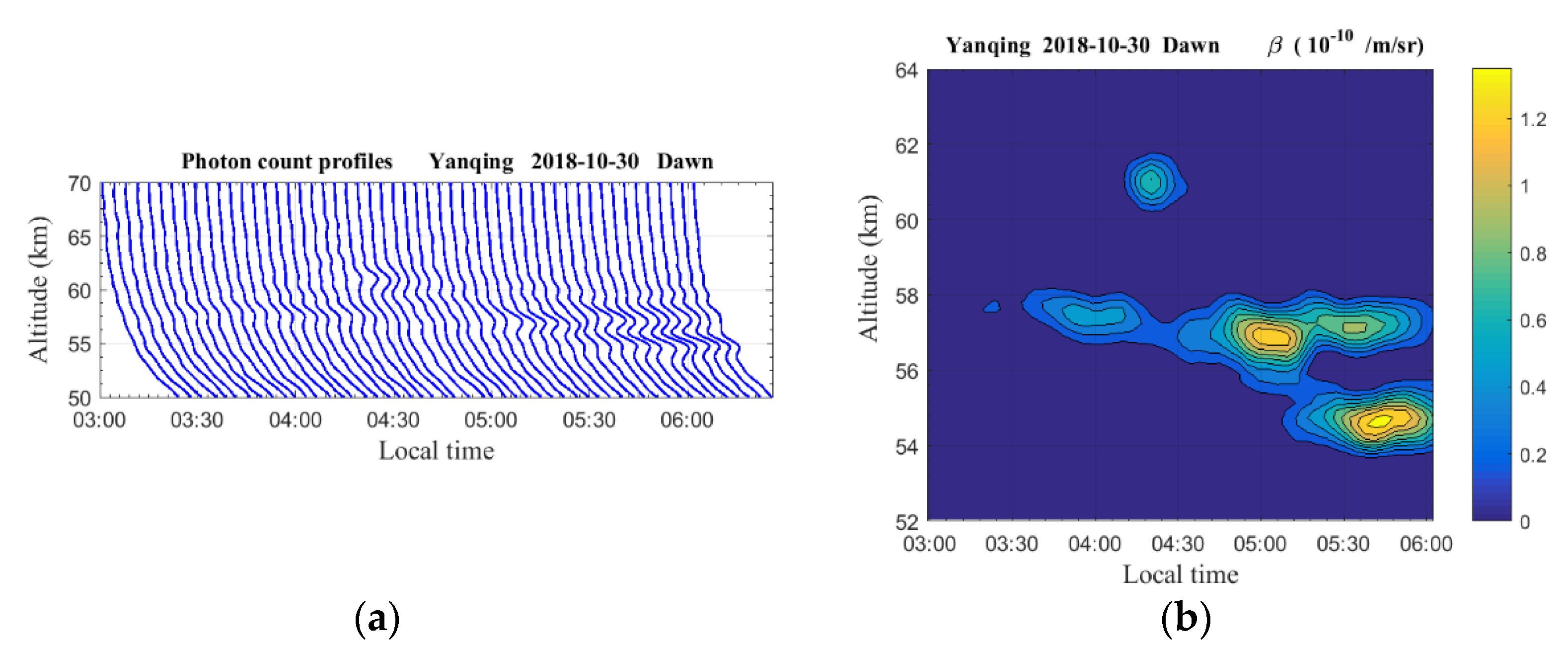


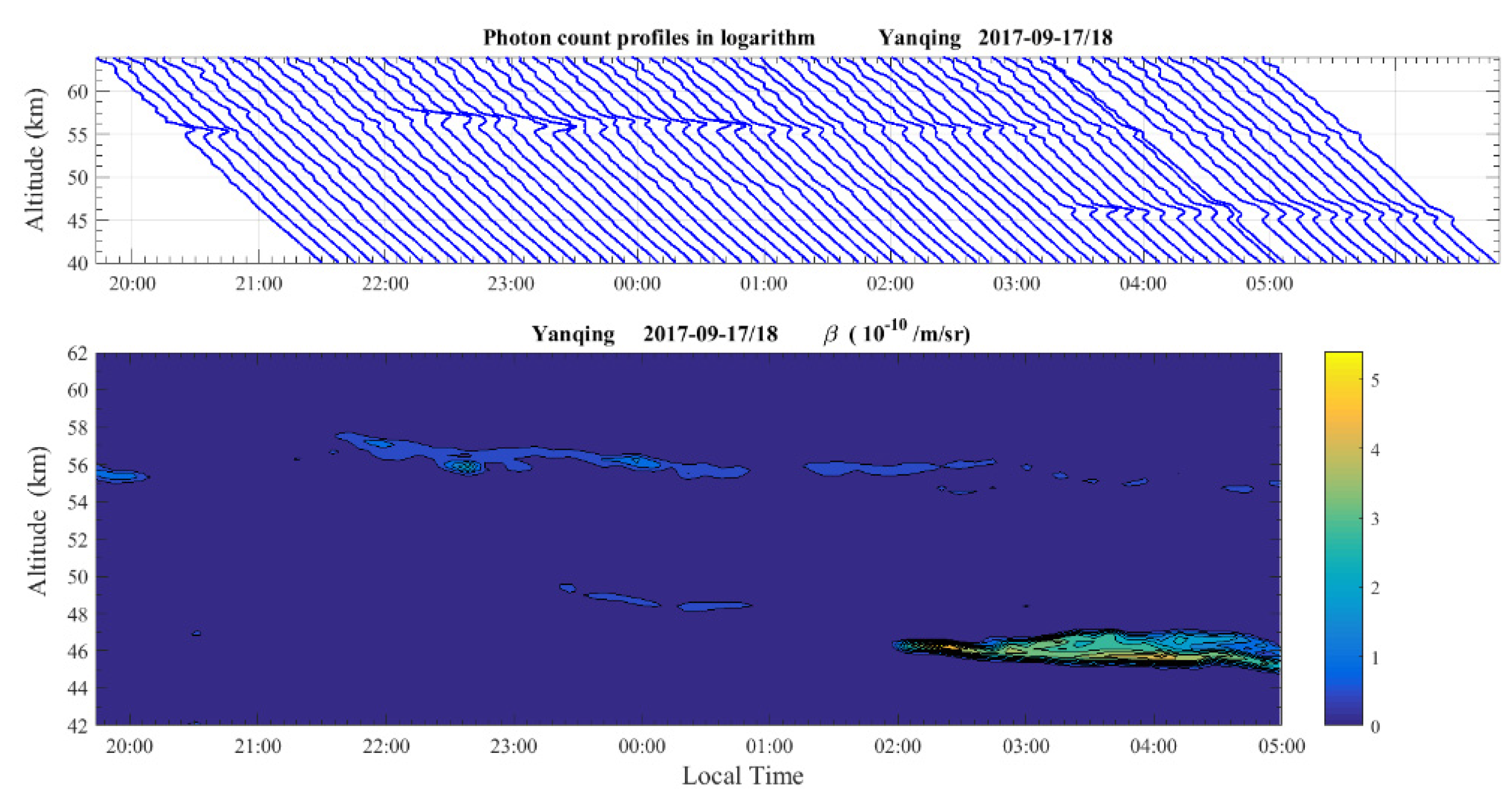
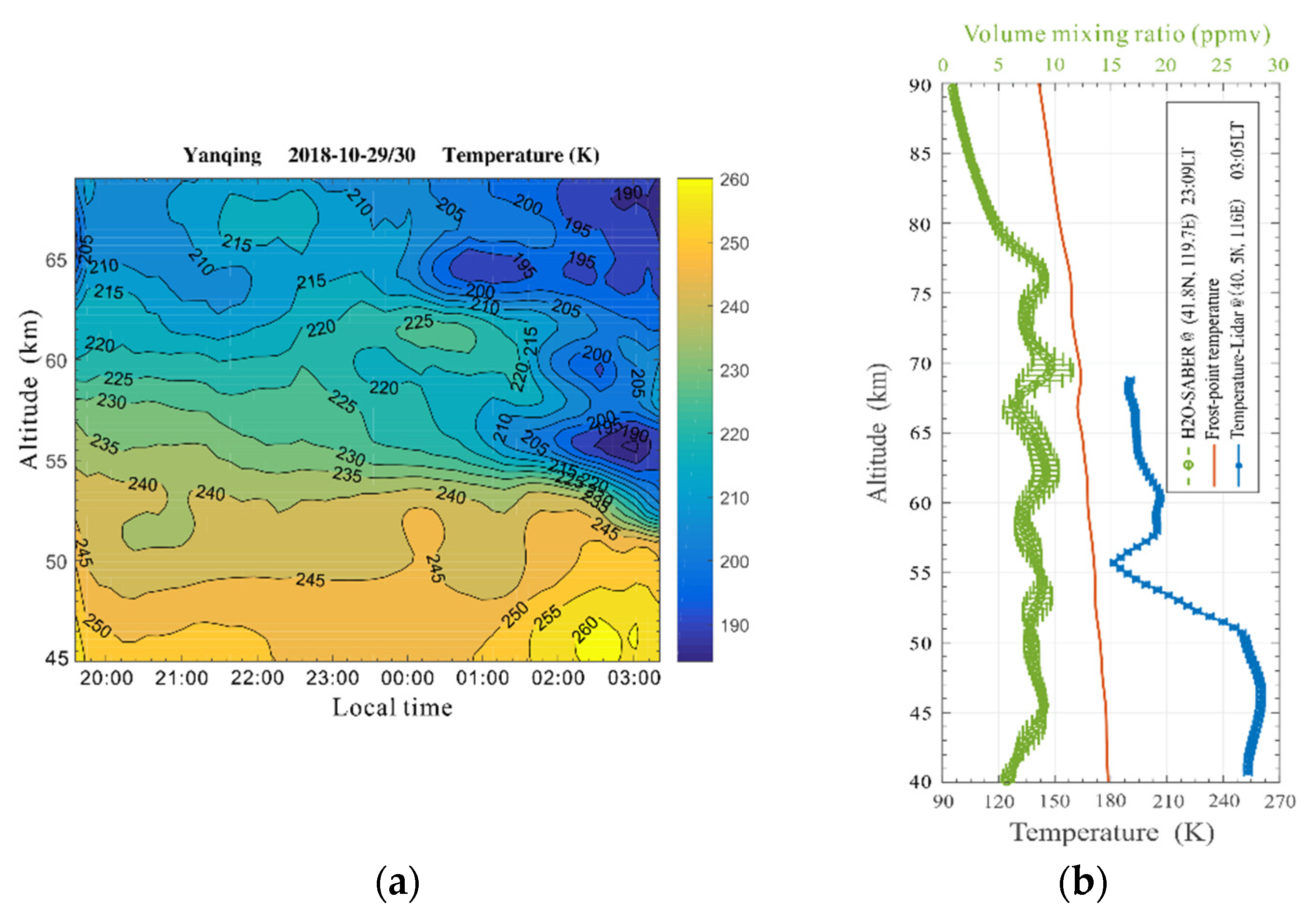
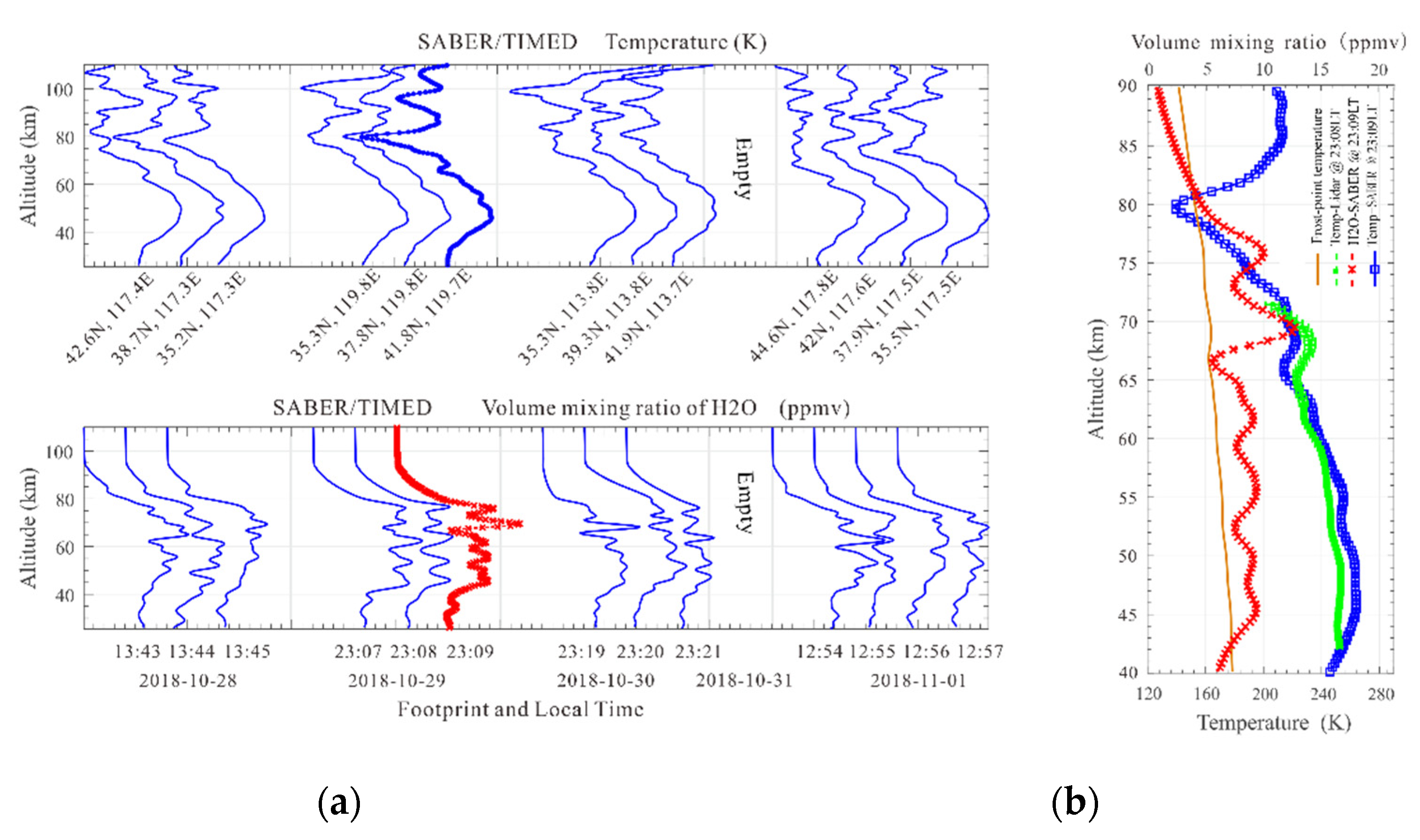
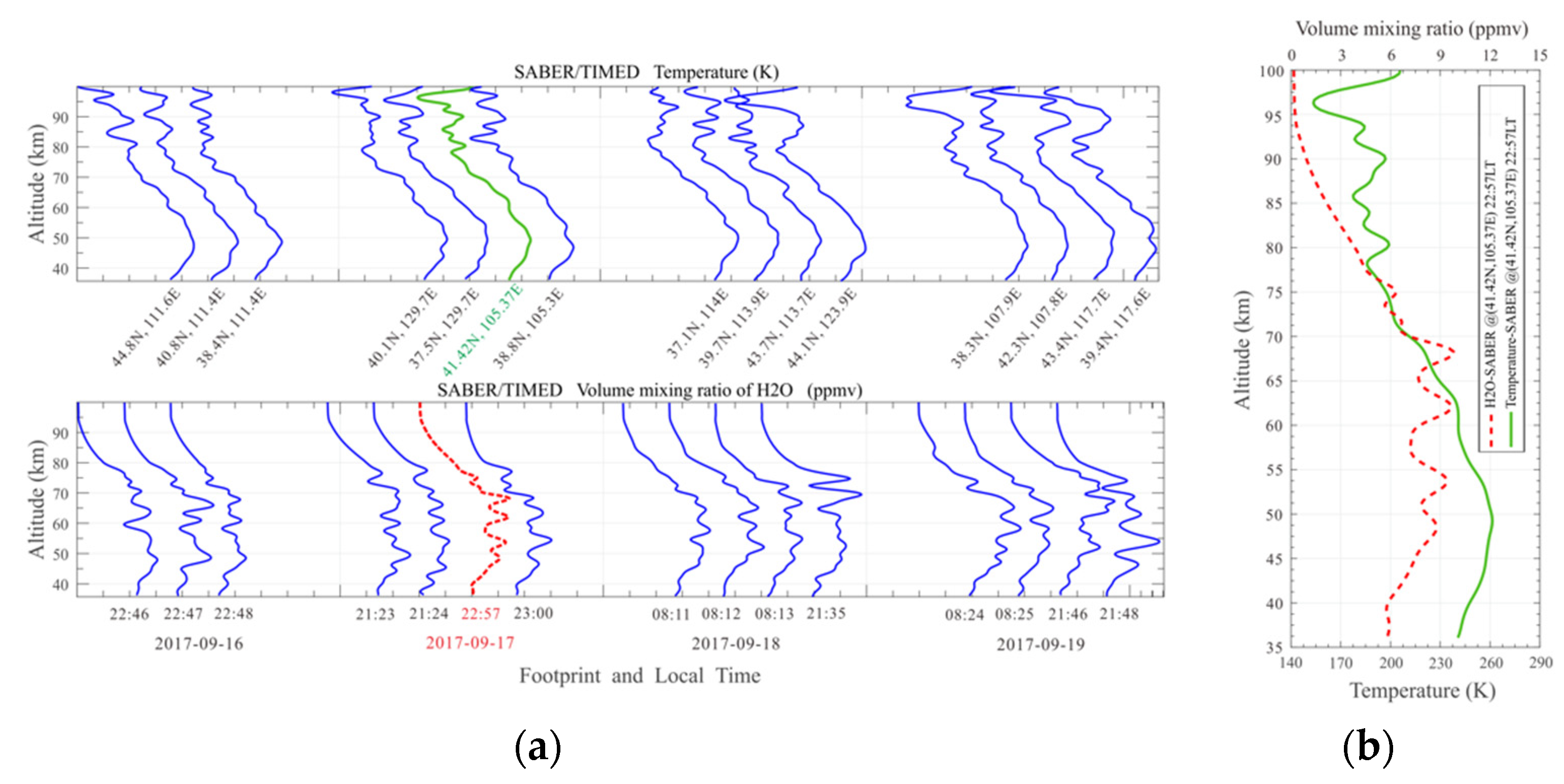
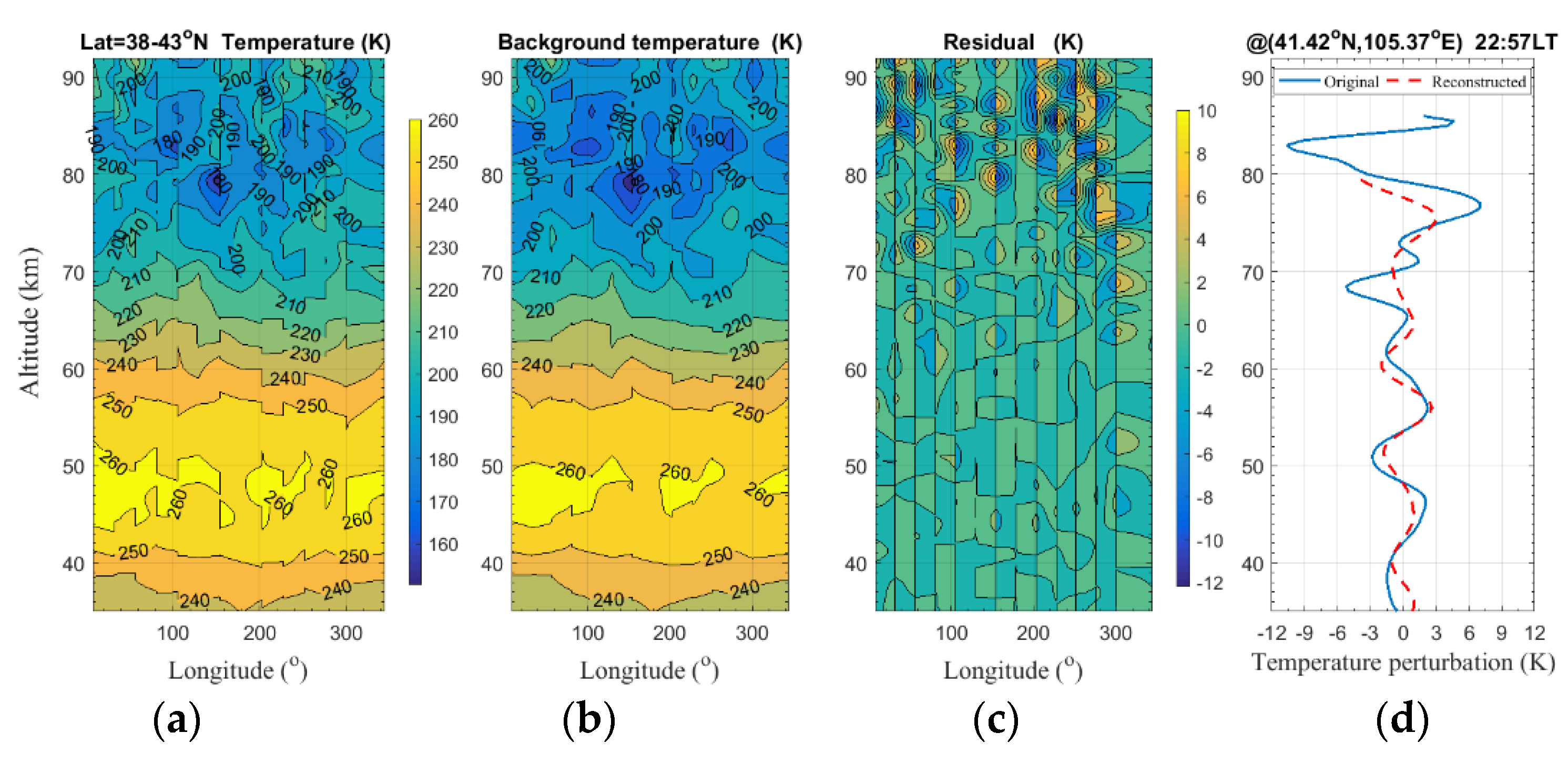
| Date | Lidar Station | Duration Time (Local Time) | Altitude Range (km) | Peak Altitude | Layer Structure | FWHM (km) | |
|---|---|---|---|---|---|---|---|
| 26 September 2010 | Yanqing | 19:00–19:30 | 43.5–45 | 2.0 | 43.8 | single | 0.20 |
| 24 September 2010 | Yanqing | 20:40–22:35 | 48–51 | 8.0 | 49.3 | double | 0.42 |
| 31 Auguest 2013 | Yanqing | 01:15–03:15 | 56–60 | 1.2 | 58 | single | ≤0.31 |
| 11 October 2013 | Yanqing | 22:45–01:00 (+1 day) | 58–60.5 | 1.6 | 58 | single | ≤0.33 |
| 22 March 2014 | Yanqing | 23:00–23:45 | 56–61 | 3.0 | 58.5 | single | ≤0.2 |
| 17 September 2017 | Yanqing | 20:00–05:00 (+1 day) | 44–58 | 5.6 | 47.2 | double | ≤0.81 |
| 27 September 2017 * | Yanqing Pingquan | 19:00–22:00 20:40–24:00 | 51–54.5 49–53 | 5.0 7.0 | 54 52 | single single | ≤0.35 ≤0.43 |
| 01 December 2017 | Yanqing | 20:45–21:15 | 37.5–38.6 | 40.0 | 38 | single | ≤0.22 |
| 05 February 2018 | Yanqing | 05:15–06:05 | 44–46 | 3.5 | 45 | single | ≤0.4 |
| 28 April 2018 | Yanqing | 22:00–02:15 (+1 day) | 46–48 | 8.7 | 47.5 | single | ≤0.35 |
| 30 October 2018 * | Yanqing Yanqing Pingquan | 03:40–06:00 18:30–19:40 18:45–00:30 (+1 day) | 53–62 57–65 54–62 | 1.2 11.2 7.2 | 54.3 61 54.5 | triple triple double | ≤0.92 ≤0.71 ≤0.64 |
| 24 November 2018 * | Yanqing Pingquan | 19:15–22:15 18:35–20:30 | 33–37.5 35–37 | 55.0 14.0 | 36.5 36.5 | double single | ≤0.30 ≤0.31 |
| 29 November 2018 | Pingquan | 19:00–21:00 | 50–54 | 25.0 | 53 | single | ≤0.45 |
Publisher’s Note: MDPI stays neutral with regard to jurisdictional claims in published maps and institutional affiliations. |
© 2022 by the authors. Licensee MDPI, Basel, Switzerland. This article is an open access article distributed under the terms and conditions of the Creative Commons Attribution (CC BY) license (https://creativecommons.org/licenses/by/4.0/).
Share and Cite
Gong, S.; Wang, Y.; Guo, J.; Chen, W.; Zhang, Y.; Li, F.; Xun, Y.; Xu, J.; Cheng, X.; Yang, G. Clouds in the Vicinity of the Stratopause Observed with Lidars at Midlatitudes (40.5–41°N) in China. Remote Sens. 2022, 14, 4938. https://doi.org/10.3390/rs14194938
Gong S, Wang Y, Guo J, Chen W, Zhang Y, Li F, Xun Y, Xu J, Cheng X, Yang G. Clouds in the Vicinity of the Stratopause Observed with Lidars at Midlatitudes (40.5–41°N) in China. Remote Sensing. 2022; 14(19):4938. https://doi.org/10.3390/rs14194938
Chicago/Turabian StyleGong, Shaohua, Yuru Wang, Jianchun Guo, Weipeng Chen, Yuhao Zhang, Faquan Li, Yuchang Xun, Jiyao Xu, Xuewu Cheng, and Guotao Yang. 2022. "Clouds in the Vicinity of the Stratopause Observed with Lidars at Midlatitudes (40.5–41°N) in China" Remote Sensing 14, no. 19: 4938. https://doi.org/10.3390/rs14194938
APA StyleGong, S., Wang, Y., Guo, J., Chen, W., Zhang, Y., Li, F., Xun, Y., Xu, J., Cheng, X., & Yang, G. (2022). Clouds in the Vicinity of the Stratopause Observed with Lidars at Midlatitudes (40.5–41°N) in China. Remote Sensing, 14(19), 4938. https://doi.org/10.3390/rs14194938









